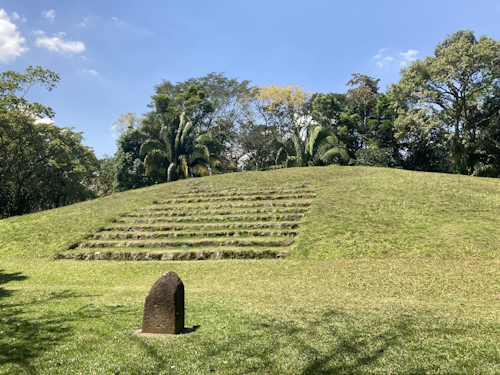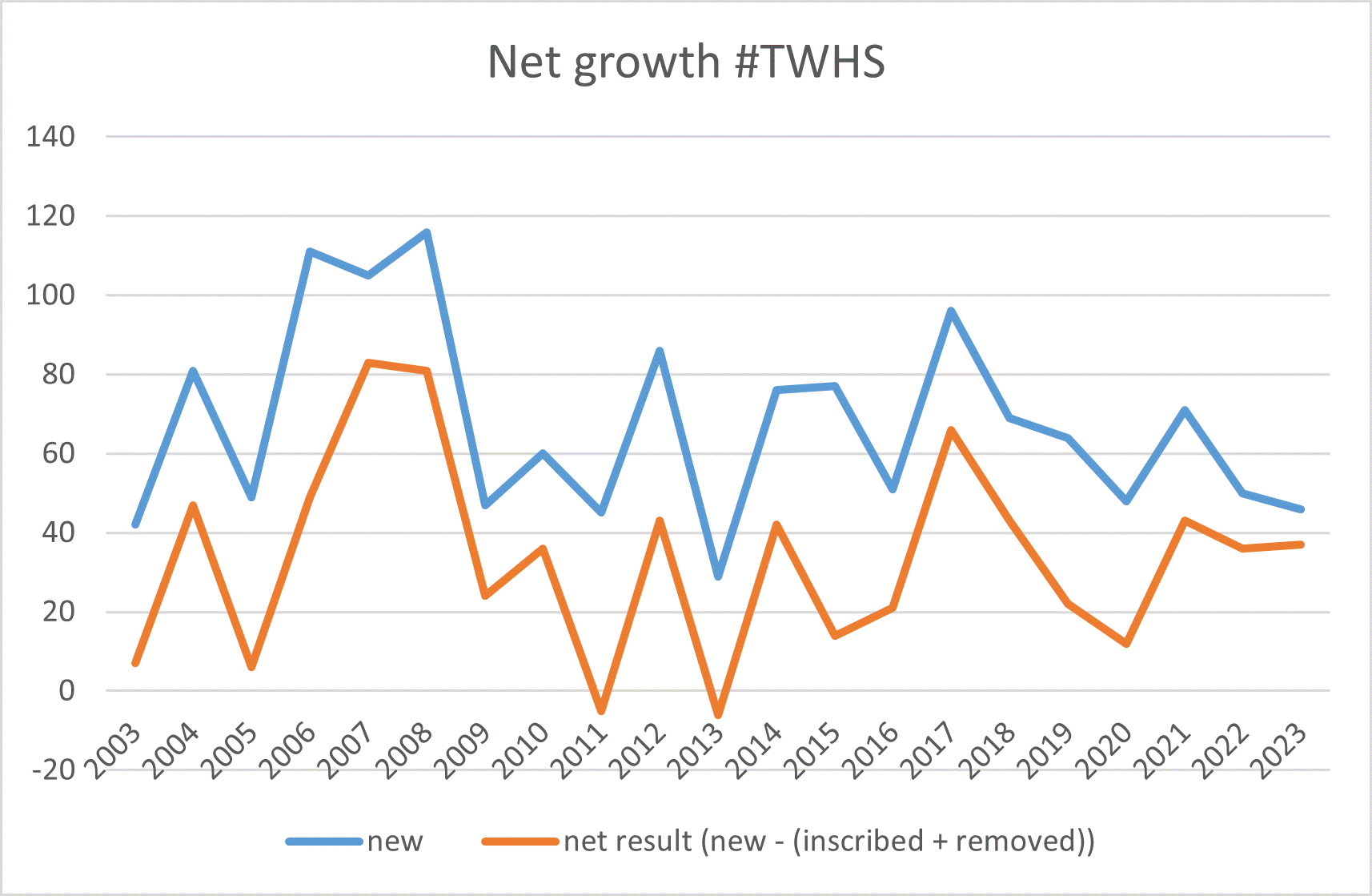Blog WH Travellers
The Value of a TWHS
The late, great WH traveller Iain Jackson was known for his specific ‘rules’ regarding the process of visiting and counting WHS. For example only counting a serial site as visited when having seen 50% +1 of its locations, or only ‘ticking’ sites after they have been inscribed. Most of us thought at the time that he had very high moral standards. But he also was very efficient, especially regarding the time spent towards sites on the Tentative Lists (TWHS): none. More and more I now notice that completing countries’ T Lists has become a goal in itself, with Nomadmania even adding WHS and TWHS into one total number, thereby implying that they are worth the same. Personally, I think TWHS should only sparsely be added to travel itineraries, and here is Why:

The ones already on the WH List are better
They’re better because
- of the process they have gone through: they’ve been prioritized by their country, have a full nomination dossier and a management plan written for them (against great cost and lots of stakeholder negotiation), have been vetted by IUCN/ICOMOS, and have been confirmed by the WHC.
- the top picks were put forward and included first. Looking for example at the Khmer and Maya sites, Angkor was included in 1992 and Tikal in 1979, Copan in 1980 and Chichen Itza in 1988. For the combined 2022/2023 session, we will be looking at Koh Ker and Tak'alik Ab'aj (photo 1) – two minor sites within the history of these empires that may hold some scholarly interest but are a far cry from outstanding.
- they gain higher praise from our community: while 89% of the current rated WHS get a rating of 2.5 stars ('average') or higher, only 71% of the rated TWHS are recommended to be inscribed by more than 50% of the voters.
Of course, the T Lists do contain some that are equal to or even better than similar, lower-rated sites that are already inscribed, or are just worthwhile to visit because they cover a particular niche that you may enjoy. But the overall average quality of the set is worse.
The success rate of an average TWHS is only 14%
From a quantitative perspective too, it makes no sense to spend time and money at random TWHS. Looking at the past 10 years (I have taken the period 2012-2021 as there was no session in 2022), 239 TWHS became included in a WHS. 145 have been removed from the T Lists in the same period. In comparison with the 1726 TWHS still left at the end of 2021, this means a success rate of just below 14% across 10 years.
The number of new TWHS grows faster than the number of new WHS
The success rate will not double to 28% across 20 years because of the high refresh rate of the TWHS. There were 667 new TWHS over the last 10 years, while only 222 got inscribed. The combined Tentative Lists have grown from 1325 in 2006 (when the first database became available on the UNESCO website) to 1780 entries at the moment of writing, while the WH List grew from 827 to 1157.

And it is not only the growth that is worrisome: the lists are highly variable as well. The Operational Guidelines of the WH Convention advise countries to reevaluate their T Lists at least every 10 years. So you can have visited all Bangladeshi TWHS and the next week they unexpectedly publicize a fully revamped list.
The T Lists have strayed from their intended purpose
Although, according to the Operational Guidelines, a Tentative List only exists to identify "those sites which they consider to be of potential Outstanding Universal Value and which they intend to nominate during the following years", the practical reality is that some countries see this much broader. And there is no one stopping them: a country can submit any Tentative List, and there is no check of its contents. That’s why we also see so many TWHS lingering there without explanation for OUV, or without geographic coordinates, or of sites that have already been inscribed. This results in some countries having very long T Lists: the Turkish one would take 85 years to deplete even if they had a successful nomination every year. As I said in my review of the Turkish ones: it looks like they have brainstormed but forgot to cluster and prioritize. These unrealistically long T Lists seem to serve mostly a domestic purpose: getting on a Tentative List is already a prize for some local or regional authority within a large country.
My personal approach nowadays is: only take in TWHS that (a) are likely to be nominated in the next 2 or 3 years, (b) sound particularly interesting, or (c) will expose me to a wholly different part of a country that I am visiting (such as El Imposible in El Salvador). But you might as well use any other resource (AtlasObscura, old-fashioned guidebooks, Aspiring TWHS etc.) for the latter two reasons. What's your take on 'ticking' TWHS?
Els - 16 July 2023
Comments
Durian 23 July 2023
Another issue of TWHS is that it is an easy loophole for corruption on local governmental budget especially what I observed in Southeast Asia or even in Japan. Having local site in TWHS will create a rightful reason to set a budget to promote or to prepare nomination without proper outcome and that money go to certain academics and local construction businesses who have connection with local politicians.
Els Slots 21 July 2023
And another 'rule of thumb' that became clear to me after browsing through the 2023 nominations: be careful with upcoming whs where the coordinates are not clear from the twhs documentation and require a (costly) detour.
Clyde 21 July 2023
I adopt a very similar approach too, but I also put in extra effort if it is in an area without many whs and of interest to me, since the chances of returning only for that extra tick would be close to zero.
Els Slots 17 July 2023
Quoting Nan Unesco should enforce a regular cleanup. If a site makes no visible progress for a decade, it should be removed from the tentative list.. Really good idea. Or order that a T List may only include 10 sites at any time. The sheer numbers make it unmanageable. The 1780 sites today would take over 50 years to get all inscribed (on an average of 35 a year and even disregarding the limit of 1 per year per country).
Nan 17 July 2023
One more point to mention. The late Iain's argument was not just rule based, but also on practical efficiency.
If you spend time and money on getting to a potential tentative site with x% probability of being inscribed, this may not be the best use of your time and money overall.
A few more observations:
* It would already help if Unesco enforced minimum documentation standards before adding sites to the tentative lists. I think there needs to be some gatekeeping between aspiring and tentative.
* It's not just Turkey referencing Unesco pre inscription. Schwerin, Germany, does, too. They have signs saying "2015 - Submitted to the tentative Unesco world heritage list" or sth in town.
* Unesco should enforce a regular cleanup. If a site makes no visible progress for a decade, it should be removed from the tentative list.
* Wondering about my in vain count... It's not that many actually :)
Meltwaterfalls 16 July 2023
I think Nan has covered my main approach. I will visit if they are easy to pick up e.g. already on my route, have a component in a city I am already visiting.
If they are scheduled for the next couple of years I will try visit. I learned the hard way with Naumberg that a negative evaluation doesn’t mean it is a dead proposition, especially in a tenacious Western European country.
And then there are some that I am interested in anyway, and the fact they are TWHS is just a bonus to a visit I was already going to make. Some that come to mind are Pamphula, Scrovegni Chapel, works by renowned C20/21 architects
Dare I say it but as with WHS themselves, these sites are a framework to build travelling around for me, not necessarily the purpose of travel itself. (Though I will admit the thrill of a tick will mostly drive me to places I would never contemplate in other circumstances)
Nan 16 July 2023
I think hunting for tentatives is a bit of a fools errant. Even with scheduled sites, the countries may change their priorities fairly late in the game, so a lot of effort is in vain.
I remember going to the Prosecco Hills 9 months before inscription. I had studied the nomination, identified key structures and went. Then the WHC cut it down and I barely made it into the greatly reduced core zone.
Last year I went to the cold deserts of Uzbekistan, but the locations were off, the description incomplete... I am not sure that the location I visited will count and I spent serious money on a 4wd plus driver.
So, how do I go about tentative sites:
* I dont go out of my way to see sites I dont care about. If i can squeeze it in along the way or need sth to do for a buffer day, it's fine.
* Scheduled tentatives are prioritised, especially if a revisit of the area is unlikely. Reason is that the success rate of scheduled tentatives unlike general tentatives is rather high.
* I make a bit more of an effort for unreviewed tentative sites.
Some practical points:
* Logistics for tentatives is often harder as they dont feature on the tourist itinerary yet.
* Without map and OUV statement it's often harder to appreciate the more exotic sites.
* Turkey uses their tentative sites for claiming, incorrectly, that these sites are unesco.
Els Slots 16 July 2023
Thanks for the clarifications regarding Nomadmania, Thomas. Hope it stays limited.
Thomas Buechler 16 July 2023
A great evaluation, Els.
Myself, I mainly visit the sites on the Tentative List, if:
a)they are nearby of my itinerary where I go anyway
b)they are proposed for inscription in the years to come
c)of great value or interest to me
d)I am with someone who wants to visit them
Nomadmania by the way does have separate lists and rankings for both UNESCO and Tentative Sites, and only combines the two in the category of 'Wonders'. On the people's individual profile the Tentative Sites don't even appear, also they are not counting in the people's ranking for TBT-biggest travelers.